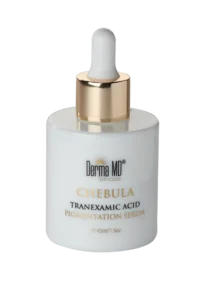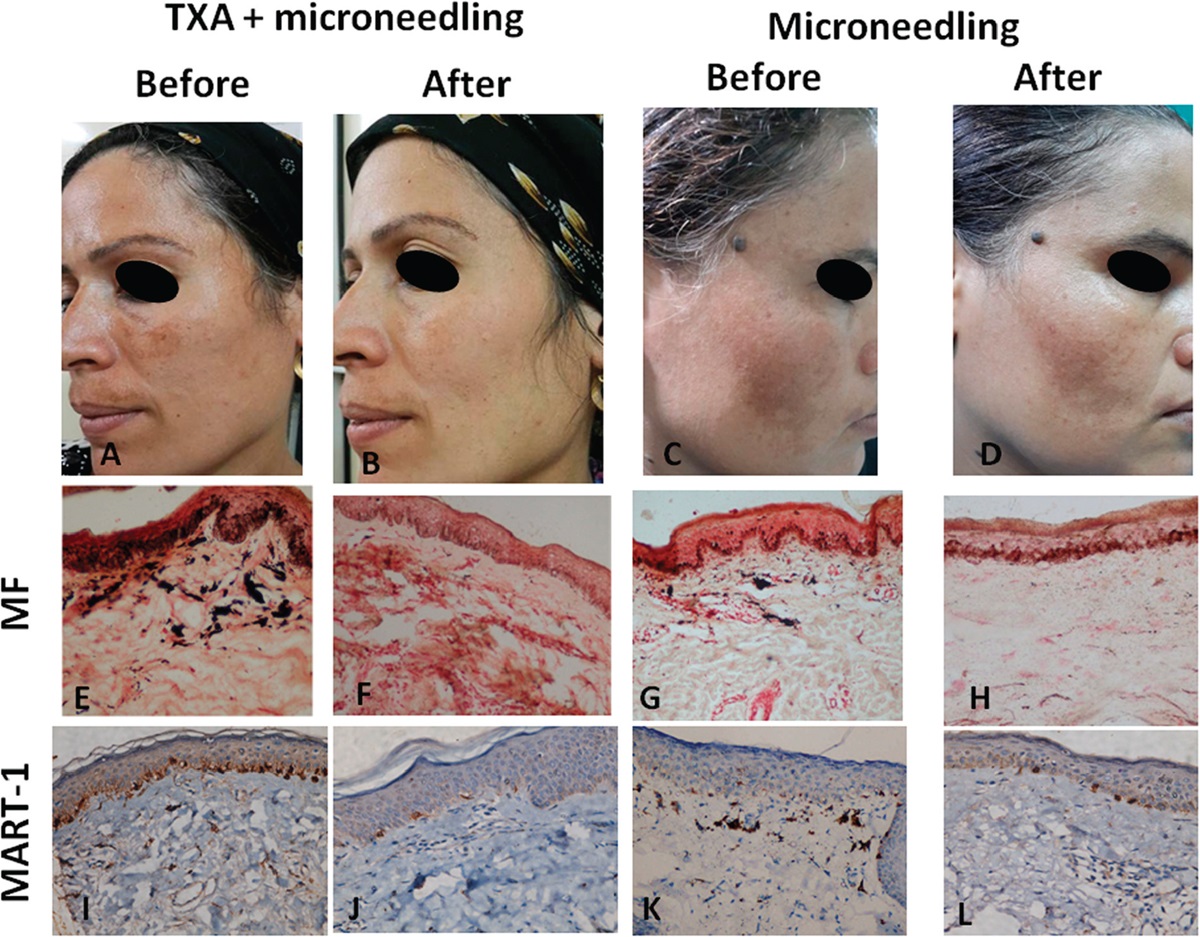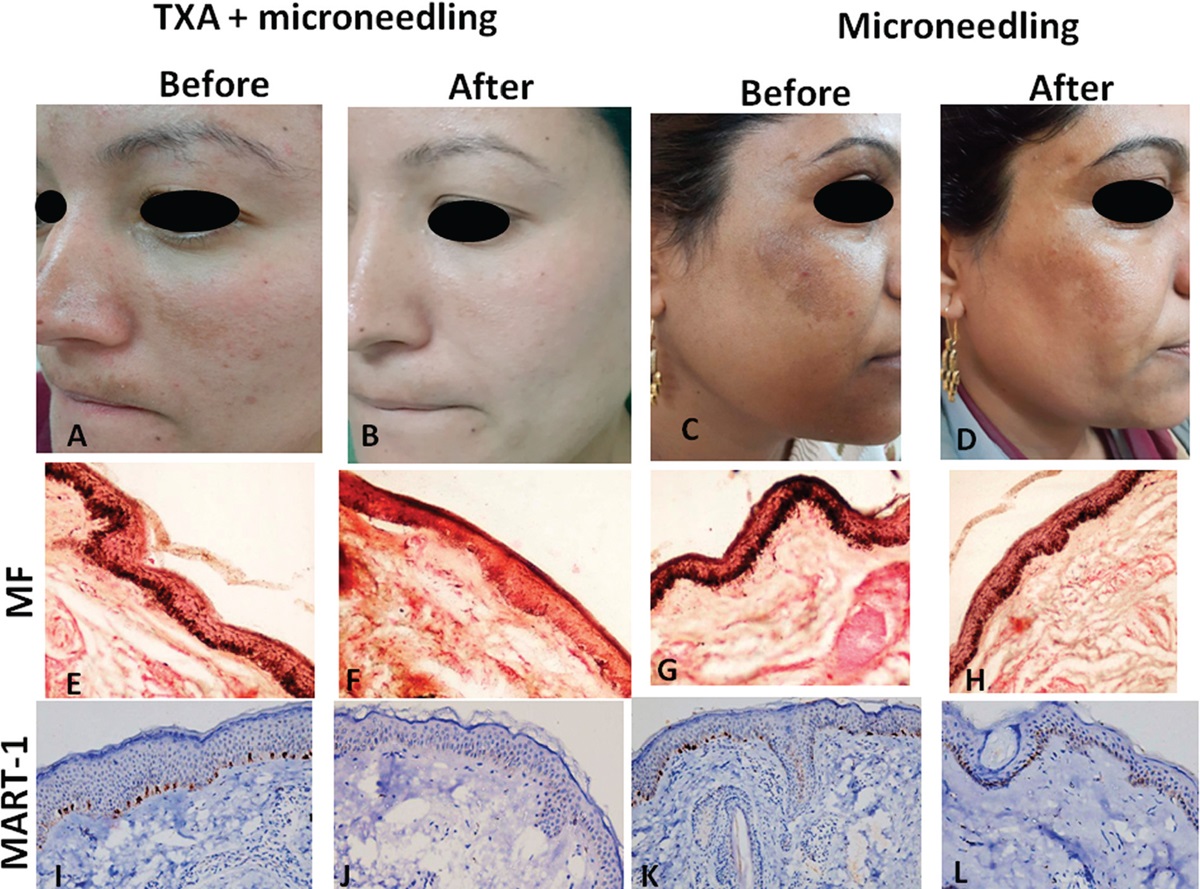Table of Contents
Unlocking the Secret to Melasma Management: Microneedling Meets Topical Tranexamic Acid
Introduction to a Revolutionary Duo
Melasma, characterized by its challenging dark patches on the skin, has met its match with the innovative combination of microneedling and topical tranexamic acid. At Laser Skin Clinic, we harness the power of this duo to deliver transformative results.
Understanding Melasma
Melasma transcends mere aesthetic issues; it’s a disorder that can profoundly impact an individual’s well-being. It presents as symmetrical, blotchy, brownish facial pigmentation and can be particularly stubborn to treat due to its potential to penetrate the skin’s superficial and deeper layers.

Book Your Free Consultation Today Or Call (647) 560-9233

Image 1: depicts female subjects with surface-level melasma prior to any intervention (a, c). Following the application of microneedling combined with tranexamic acid, there’s a notable enhancement (b), whereas microneedling alone yields a less pronounced improvement (d). Tissue samples from the melasma reveal a heightened concentration of melanin within the epidermis (e, g) and an increase in cells stained for MART-1, a melanoma-related marker (i, k). Post-treatment, the samples show a reduction in both melanin concentration (f, h) and the presence of MART-1-stained cells (j, l), with a more significant decrease observed in patients treated with the combination of microneedling and tranexamic acid (e–f, MF, ×200; i–l, MART-1, ×200). Here, MART-1 stands for melanoma antigen recognized by T cells-1, and MF denotes the Fontana Masson.

Image 2: illustrates women with combined-type melasma before any procedures (a, c); significant enhancement is seen after using microneedling with tranexamic acid (b), while only microneedling leads to a slight improvement (d). Biopsy samples from the mixed melasma areas reveal a higher concentration of melanin (e, g) and cells marked by MART-1 (i, k) in both the epidermal and dermal layers. Following the treatments, there’s a marked reduction in melanin levels (f, h) and the number of MART-1 positive cells in these skin layers (j, l), as shown in the magnified biopsy images (e–f, MF, ×200; i–l, MART-1, ×400). Here, MART-1 refers to the melanoma antigen recognized by T cells-1, and MF indicates the Fontana Masson staining method.
Source: journals.lww.com
The Power of Microneedling
Microneedling is a gentle procedure that induces tiny punctures in the skin’s surface. It prompts the body’s natural healing process and boosts collagen production. But its benefits extend beyond rejuvenation.
A Gateway for Treatment
These micro-injuries act as channels, allowing active ingredients, like tranexamic acid, to penetrate deeper into the skin layers where melasma resides, making the treatment more effective.
Topical Tranexamic Acid: The Game Changer in Melasma Treatment
Tranexamic acid, originally used in medicine to manage heavy bleeding, has now become a powerful ally in treating melasma. This skin condition, characterized by dark, discolored patches, has long posed a challenge for both patients and dermatologists. However, the application of tranexamic acid directly to the skin has marked a turning point in treatment strategies.
When applied as a topical agent, tranexamic acid works by targeting the melanocytes, the cells responsible for pigment production in the skin. It successfully suppresses the production of melanin, which is responsible for skin pigmentation and can cause the darkened areas characteristic of melasma when overproduced. By preventing the melanocytes from overproducing melanin, tranexamic acid gradually lightens the pigmented areas, resulting in a more even skin tone.
The transformative power of tranexamic acid lies in its dual action. Not only does it reduce the appearance of existing pigmentation, but it also prevents new patches from forming. This preventative aspect is crucial for those who suffer from melasma, as it can often recur or worsen with sun exposure and other triggering factors.
At Laser Skin Clinic, we’ve harnessed the potential of topical tranexamic acid, integrating it into our comprehensive approach to melasma management. Our patients have experienced remarkable improvements, with many reporting a significant reduction in the visibility of their melasma patches. This innovative treatment, combined with our expertise in microneedling, offers a new hope for achieving clearer, more radiant skin.
Synergy for Success
When combined with microneedling, tranexamic acid’s efficacy is significantly enhanced, offering a promising solution for those battling melasma.
Laser Skin Clinic: Your Partner in Melasma Care
At Laser Skin Clinic, we’re dedicated to providing personalized care. Our expert team tailors the microneedling procedure with topical tranexamic acid to meet your skin’s unique needs, ensuring the best possible outcome.
Join the Journey to Clearer Skin
Embark on a journey to reclaim your skin’s natural beauty. Contact us today to learn more about this cutting-edge treatment and schedule your consultation.
Q&A
- What is microneedling, and how does it help with melasma?
Microneedling is a low-impact technique that employs slender needles to produce small openings in the skin. This stimulates the skin’s healing process, increasing collagen production and allowing better absorption of topical treatments like tranexamic acid, which can improve the appearance of melasma.
- Is topical tranexamic acid safe for all skin types?
Topical tranexamic acid is generally safe for most skin types. It’s advisable to seek a dermatologist’s guidance prior to beginning any new treatment, particularly for those with sensitive skin or a history of allergies.
- How long does it take to see results from this treatment?
Outcomes may differ based on each person’s unique skin characteristics and the intensity of their melasma. Some patients may see improvements within a few weeks, while others may need several months of consistent treatment to notice significant changes.
- Can microneedling with tranexamic acid permanently cure melasma?
While this treatment can significantly reduce the appearance of melasma, it is not a permanent cure. Melasma can be a chronic condition; maintenance treatments may be necessary to manage its recurrence.
- Are there any side effects associated with this treatment?
Typical reactions to microneedling may encompass temporary redness, puffiness, and a slight sensation of discomfort right after the treatment. These typically resolve within a few days. Topical tranexamic acid may cause mild irritation in some individuals.
- How often should I undergo microneedling with tranexamic acid?
The frequency of treatments will depend on your specific case of melasma and the protocol recommended by your dermatologist. Typically, sessions are spaced 4-6 weeks apart to allow the skin to heal properly between treatments.
- Can I combine this treatment with other melasma therapies?
Yes, microneedling with tranexamic acid can be part of a comprehensive melasma treatment plan, including other topical agents, sun protection, and lifestyle modifications. Always discuss with your dermatologist for a tailored approach.
Clinical Microneedling Facial with Tranexamic Acid Treatment Plan
For treating sun damage, dark spots, melasma, hyperpigmentation and to lighten & brighten skin tone.
Pre-Care at home 2 – 4 weeks prior to Microneedling
- Enzyme Cleanser – Gentle Cleanser AM/PM
- Chebula Skin Renew Antioxidant Serum AM
- Sun Protect Chebula Moisturizer w/ Zinc Oxide 25% AM
- Micro-Peel Crème 2-3 times per week PM
- Chebula Tranexamic Acid Pigmentation Serum PM
Treatment
1. Pre-Treat
- Cleanse face with Enzyme Cleanser making sure there is no residue. You may need to double cleanse if the client has heavy
makeup. Remove the cleanser with tepid water and pat dry.
2. Treatment
- Apply a layer of Chebula Tranexamic Acid Pigmentation onto the face. Needle in……To maintain glide you can add as you
move around the face. - Perform Microneedling or Plasma Pen Treatment avoiding the eyes.
Massage any remaining product into the skin.
3. Post Treatment
- Apply a layer of Copper Co-Enzyme Q10 to hydrate and promote healing
- Apply Sun Protect
- Client to stay out of direct sunlight for 48 hours
Post-Care at home:
- Enzyme Cleanser AM/PM
- Chebula Skin Renew Antioxidant Serum AM
- Sun Protect Chebula
- Moisturizer w/zinc oxide 25% AM
- Chebula Tranexamic Acid Pigmentation Serum PM
- Chebula Over Night Brightening Mask PM

